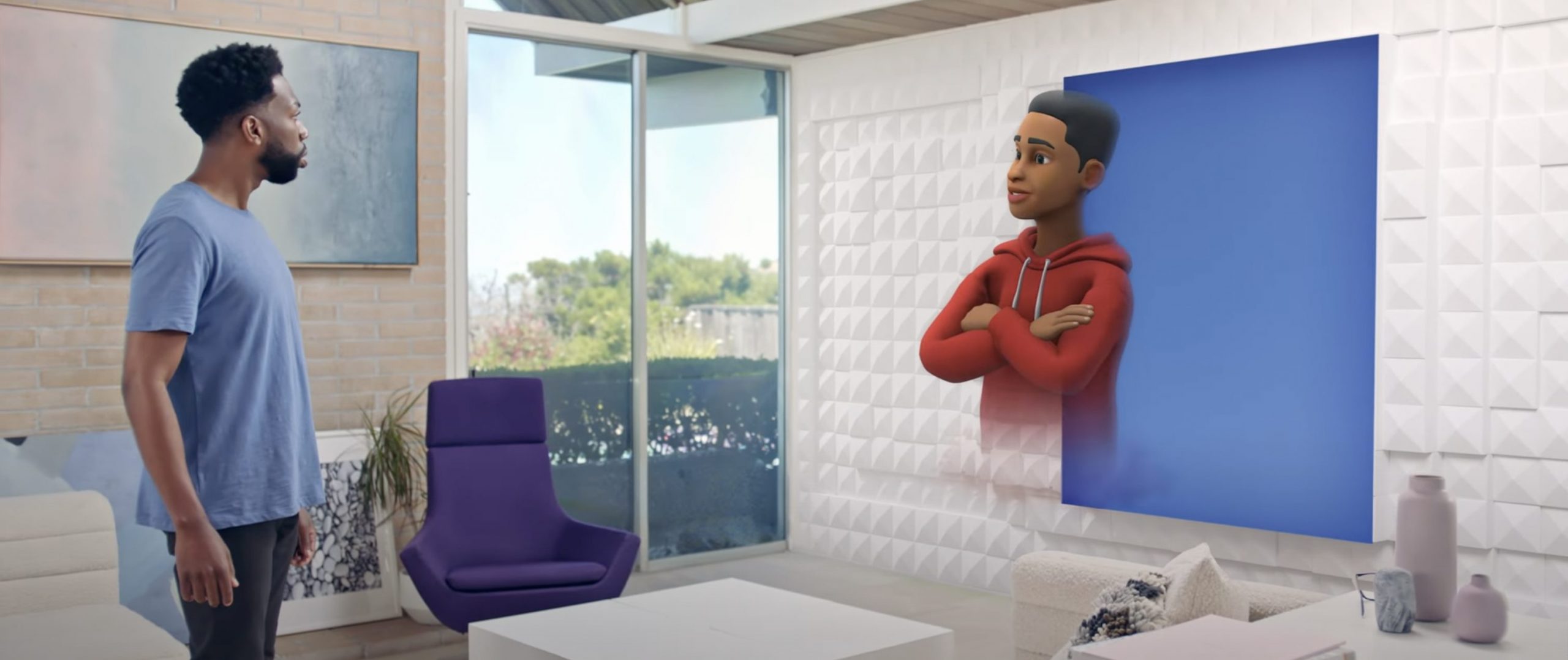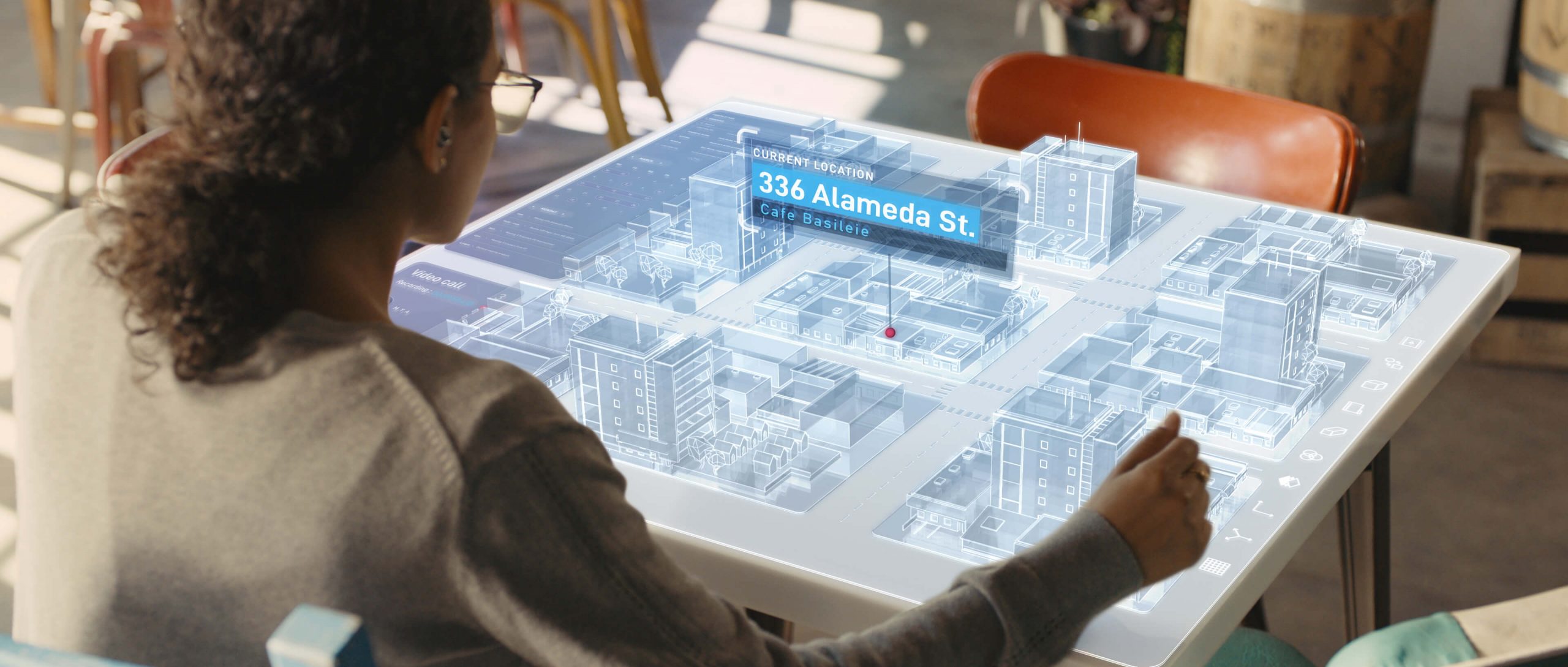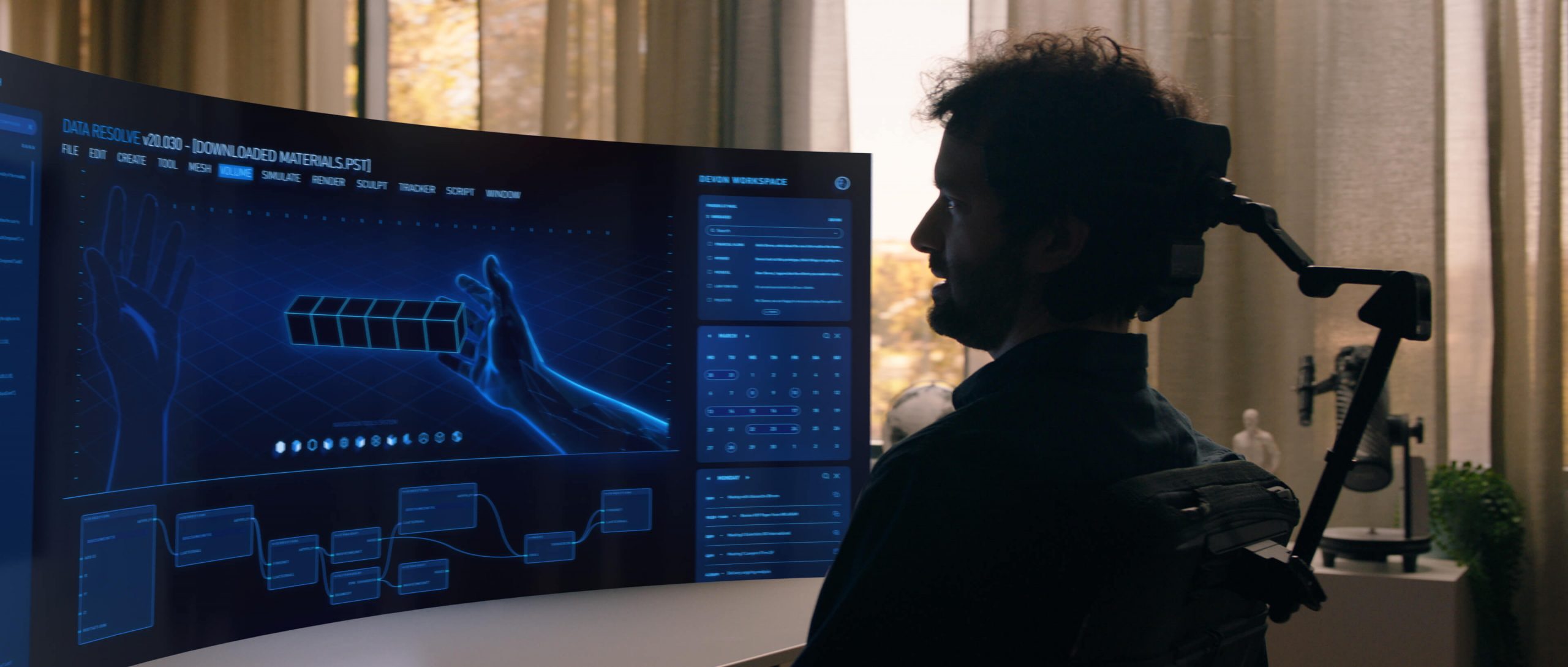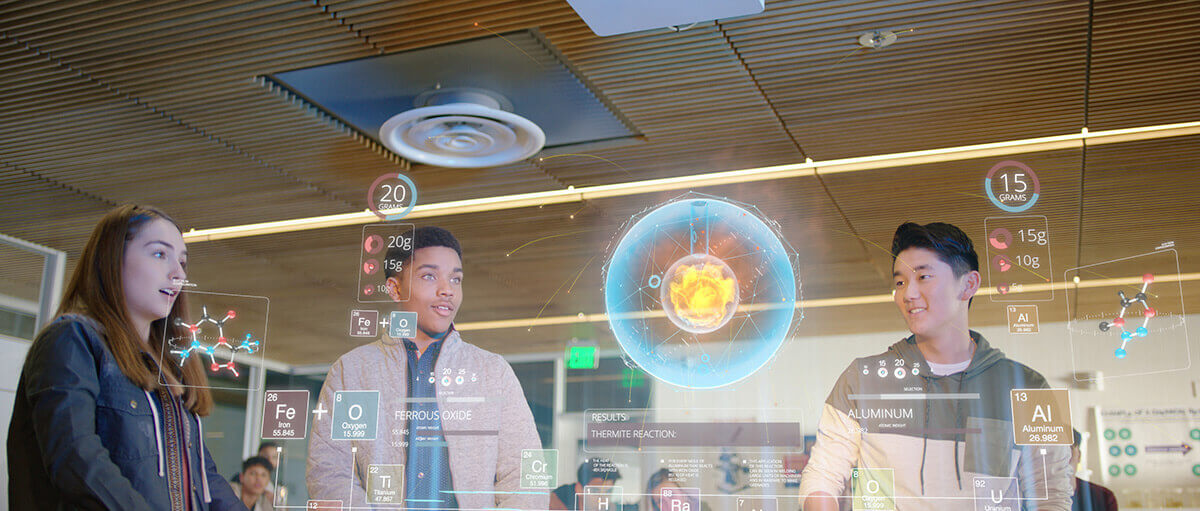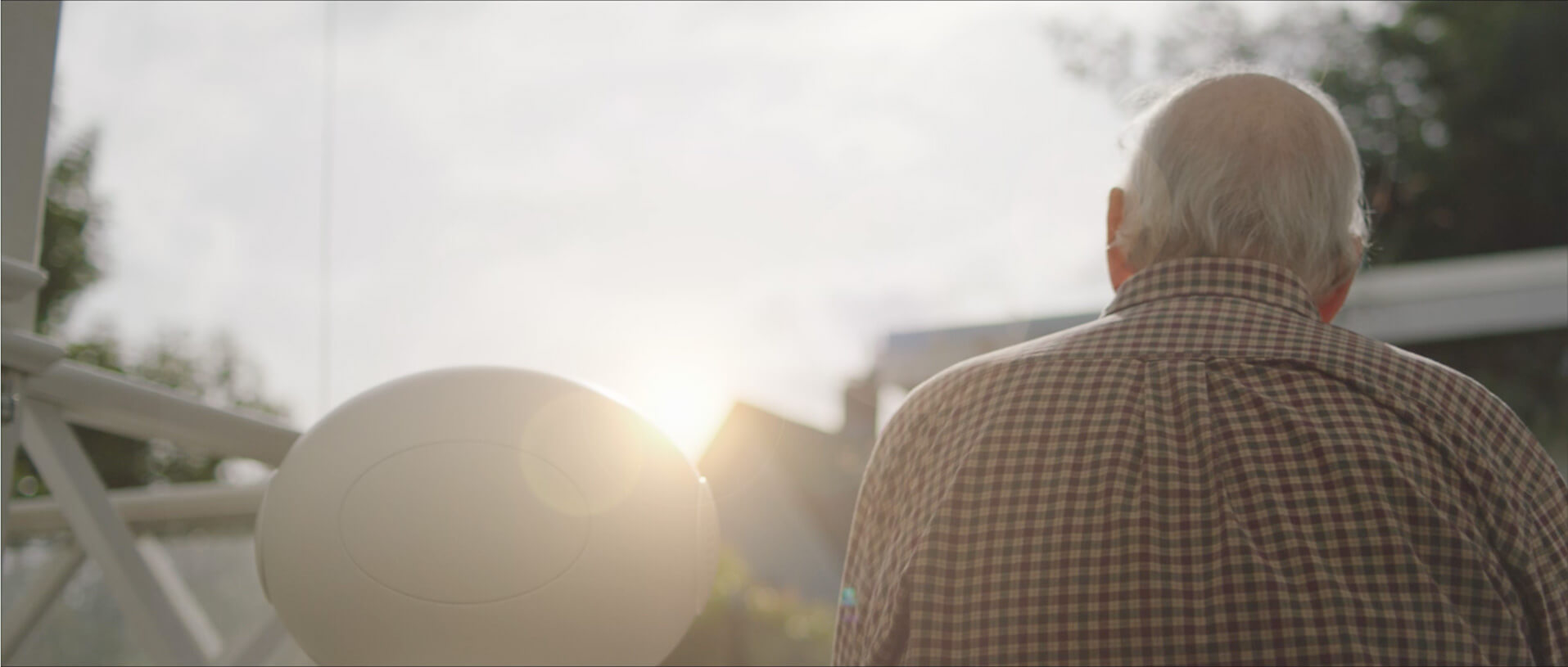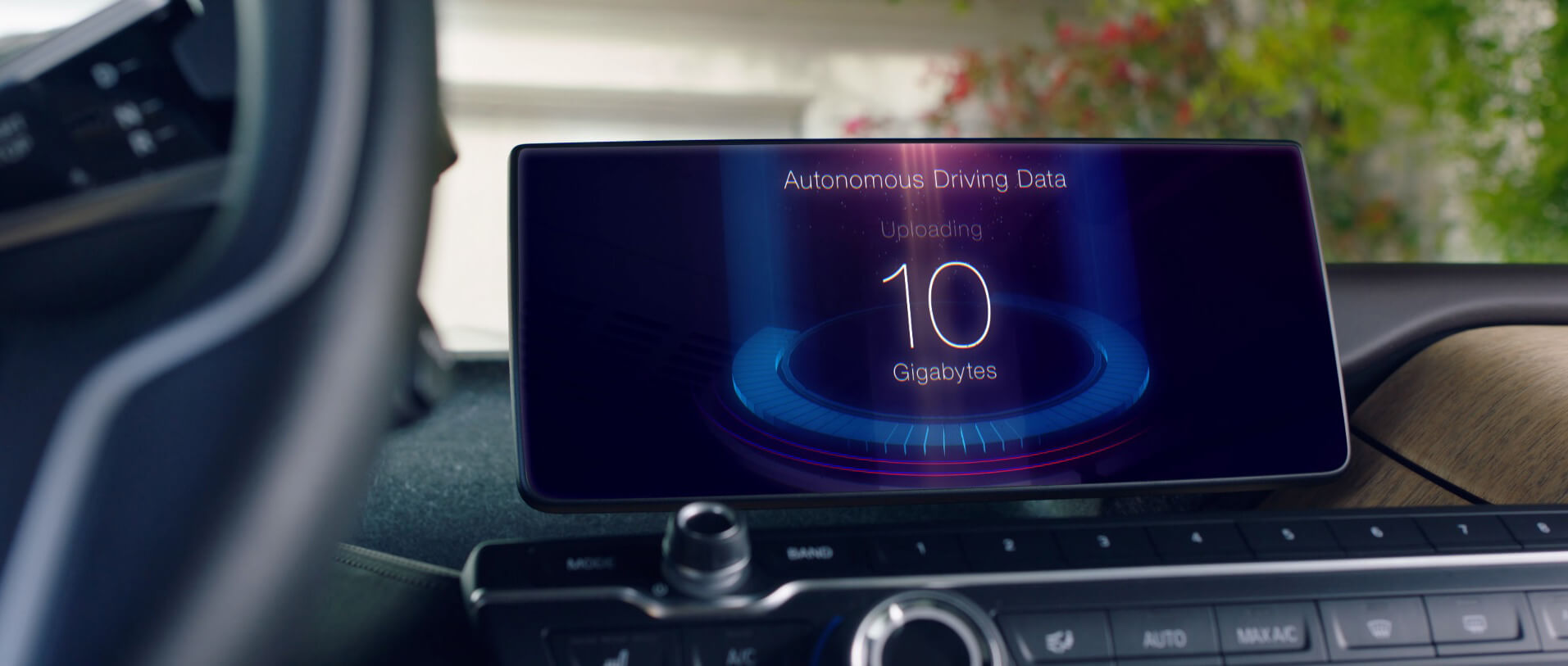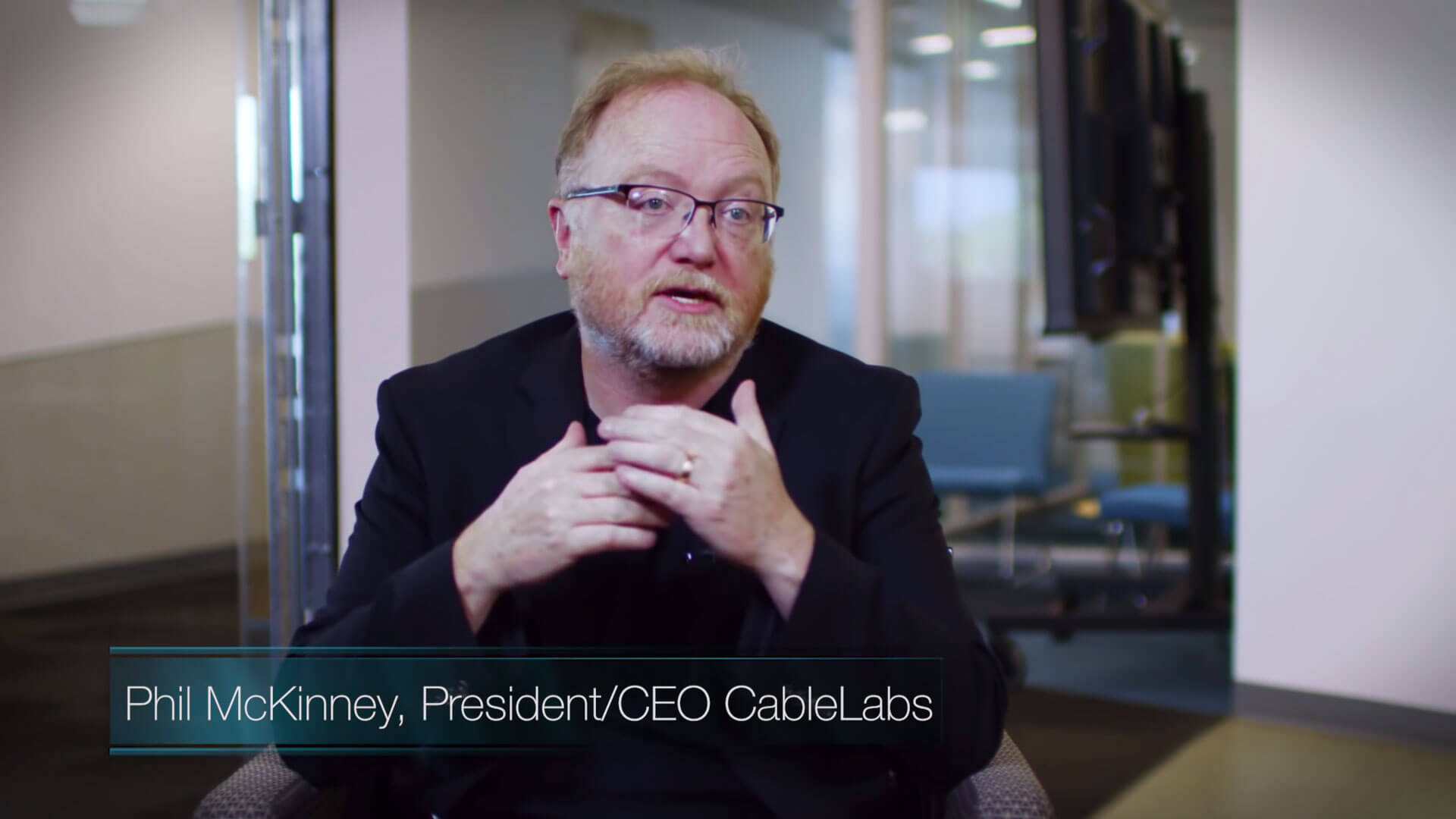The Near Future
The Near Future films are produced to help innovators imagine future ways that people may interact in a highly connected and immersive world. When we can deeply envision and experience possible futures, we can better imagine the supporting technologies needed to enrich our lives, our businesses and our communities.
The Films / Story
-
The Near Future
Step Inside
-
The Near Future
Diverse Thinkers Wanted
-
The Near Future
Ready for Anything
-
The Near Future
A Better Place
-
The Near Future
Bring It On
Behind the TechThe Near Future. Step Inside.
The latest film, “Step Inside,” provides an exhilarating vision into a possible future for Clara, Ben and their kids. Watch as they walk with prowling tigers, redirect ships to safety in a hurricane and receive calming guidance—and, sometimes, a joke or two—from their personal avatars.
Immersive Media
Immersive media of the near future will go well beyond what current flat-screen displays and virtual reality headsets deliver today. Through experiences enabled by holographic and light field technologies or augmented reality (AR) smart glasses, users will be able to perceive realistic depth and experience greater immersion in their virtual experiences. In the film, the capabilities of this technology are on display as the kids engage with a talking orange cartoon rabbit and a hyper-realistic tiger on the move.
Light Field Displays
A game-changer in 3D imaging, light-field displays don’t require glasses or headsets to deliver fully immersive experiences like what is seen in the film during Ben’s first interaction with his avatar through a wall-size light field display. The technology makes holographic media possible by producing realistic depth that can be experienced by multiple viewers at the same time, unlike 3D cinema or other immersive media experiences that require special glasses or head-mounted displays (HMDs).
Holographic Telepresence
Holographic displays will enhance social interaction by allowing multiple users to experience the same three-dimensional media seamlessly from different angles. In the near future, holographic telepresence technology could be delivered via life-size holographic stages. This type of cutting-edge and interactive technology is illuminated in the film when Ben’s son is on his field trip, when Clara gives her CEO presentation, and when the team briefs Clara on the hurricane and they observe the storm projection scenario simultaneously.
Advanced AI Avatars
Welcome to the metaverse. Population: limitless. Artificial intelligence (AI) avatars of the future will include assistants, entertainers, teachers and countless other personas designed to enrich our digital lives through authentic, human-like communication. They can appear as cartoon figures, like Ben’s avatar in the film, or as photorealistic as Clara’s assistant—and everything in between. These virtual characters will be brought to life through emotive AI solutions, working with natural language systems and the visual interface of each avatar’s facial and body language.
AR Smart Glasses
Augmented reality (AR) smart glasses of the future will go beyond the head-mounted displays we are familiar with today, enabling us to take part in richer, more immersive media experiences wherever we are. Presenting like the standard eyewear we use now, these new, technologically sophisticated glasses will allow us to interact with digital objects and information overlays directly within our field of vision. The wearable technology will seamlessly bridge our real-world experiences with our digital lives. In the film, the smart glasses worn by Ben and Clara allow them to see and communicate with their avatars anywhere they go.
Quantum Computing
With quantum computing, computations that are too complex for today’s computers will become commonplace in the future, providing the power to solve some of the world’s biggest problems. The hurricane simulation scene in the film is designed to show off this game-changing technology in action. Because of the dataset size and processing required for such a weather simulation, this highly detailed virtual scenario could only be made possible through quantum computing.
Behind the TechThe Near Future. Diverse Thinkers Wanted.
We’ll soon be able to access all the information we need, whenever we need it—without moving a muscle. A suite of smart, intuitive technologies will transform the way we collaborate and solve problems, boosting creativity and productivity in every aspect of our professional and personal lives. The future of work never looked brighter.
-
LiveTechnologies like autonomous taxi fleet and ear-piece AI will transform our lives, giving us more freedom to enjoy the things that matter most.
-
WorkNew tools based on holographic technology will change the way we approach problems and find solutions in a team environment.
-
LearnMixed-reality applications will enable learning on the go, providing valuable tidbits about everything we see around us.
-
PlayThe same technology that allows us to be more productive can be used as a fun way to display interactive information.
On-Call Mixed Reality
Mixed reality (MR) tech incorporated into everyday objects, like eyewear, will give us the near-superhuman power to access relevant information about anything we see, without the extra step of using a handheld device. Helpful overlays will instantly appear in our line of vision when we need them, providing instant guidance, such as street addresses and much more, as we go about our day.
Public Light Field
Multi-user public light field displays will take collaboration to the next level. No matter where they are, coworkers will be able to interact and share information seamlessly. Just like in the film, the light fields of the future will be capable of projecting complex virtual objects that anyone can see and manipulate in real time. And if one-on-one conversation is required, team members can always enable a private session through a secure channel.
Autonomous Taxi Fleet
Hailing a cab will become a thing of the past, thanks to next-generation ride sharing technology. Once we’ve signed up for the service, an autonomous taxi will always be available to take us anywhere we need to go at a moment’s notice. There’s no need to drive—or even own a car. Just hop in and go.
Layered Video Conferencing
Future layered videoconferencing solutions will allow us to interface with our teammates in a way we’ve never done before. Traditional video will be enhanced with the latest mixed reality and virtual reality tech that will help get everyone on the same page, eliminate distractions and allow us to focus on the thing that matters most: coming up with brilliant ideas.
Ear-Piece AI
Continuous AI assistance will give us the ability to make smart, calculated decisions on the fly. As depicted in the film, Nikki’s ear-piece AI can confirm important information, schedule an impromptu meeting, reserve a holo-room, provide on-the-go directions, replay messages and follow a variety of other instructions without ever slowing her down. The applications of this type of technology are endless.
Holo-rooms
With the advancement of holographic telepresence technology, our workspaces are getting a major upgrade. New high-tech meeting rooms will come equipped with light field displays and tables that can render 3D projects in volumetric space. This will forever change the way we collaborate, allowing us to make better decisions faster.
Alternative Interfacing
Next-gen technology will allow us to perform tasks in new and unexpected ways. For example, in the film, Nikki’s coworker is able to manipulate a virtual object by simply moving the gaze of his eyes. In the near future, this type of alternative interfacing will become part of our regular workday.
Affordable Light Field Units
As with any new technology, widespread adoption of light fields will help drive down price, allowing manufacturers to create smaller, more affordable units for everyday use. They will eventually be installed at museums, libraries, train stations or any other public space to display helpful information in a new, interactive way.
Behind the TechThe Near Future. Ready for Anything.
Let’s explore the near-future technology that will revolutionize the way we absorb new information and redefine education as we know it. With the right tools, you can learn about the world—and the entire universe—by experiencing it firsthand. Welcome to the future where knowledge is limited only by your imagination.
-
LiveAI will be present in our everyday lives, striking a balance between a trusted guide and a friend who knows what we need and when.
-
LearnTechnology will help us visualize complicated problems in a new way, making learning a seamless and enjoyable experience.
-
WorkTeam members from different locations will meet in shared digital spaces and effectively collaborate in real time.
-
PlayLearning and fun will become synonymous, allowing kids to follow their imaginations into virtual worlds where anything is possible.
Head-Mounted Displays: AR/VR
Virtual Reality (VR) and Augmented Reality (AR) technologies can teleport the wearer into any virtual environment—from a tropical jungle to the surface of the moon—in an instant. These truly lifelike and fully immersive experiences make learning an enjoyable and social activity for children of all ages. Head-mounted display (HMD) technology can integrate real-life objects and present relevant information in a way that young minds can easily understand, blurring the line between education and fun.
Video Wall
Full wall displays take remote collaboration to a whole new level, making it easier than ever to interact with people over long distances in real time. In the film, kids from different schools are working on a common project, moving objects around and writing directly on the wall as if they are in the same room. The wall projects life-size video with zero latency, which makes their interaction seem very natural.
Artificial Intelligence Media
Seamlessly integrated into everyday life, Artificial Intelligence (AI) assistants are the perfect tools to stimulate creativity and problem-solving. In the film, Millie’s assistant, represented by a wearable device on her wrist, provides the information Millie needs whenever she needs it. But AI much more than a schedule reminder. AI technology can interpret how its owner is feeling at any given moment and deliver timely guidance throughout the day in a very human-like manner.
Internet of Things
By communicating with various sensors in the area, Internet of Things (IoT) devices can instantly collect and interpret the data as you need it. The kids working in the garden use IoT sensors and handheld devices to determine the composition and moisture level of the soil, as well as look up a suspicious-looking insect, without stopping what they are doing. Having relevant information at your fingertips will give productivity an instant boost.
Light Field Table
A complex chemistry experiment or any other classroom conundrum is a breeze once you visualize the problem. A holographic light field table can project any digital object into volumetric space so students can see what’s happening with their own eyes right in front of them. They can also manipulate holographic objects, such as chemical elements or workflow charts, making learning a very effective, hands-on activity.
Light Field Holodeck
Light Field panels on adjacent surfaces create a Holodeck capable of projecting media that can actually be experienced and manipulated in volumetric space. This technology can be extremely useful for remote collaboration where participants can join in using photorealistic avatars. It looks and feels like they are sharing the same space, seamlessly interacting with the object they are working on and with each other as they would in real life.
Behind the TechThe Near Future. A Better Place.
It’s not what we create, but why. What is even more incredible than the future tech, is what the creations make possible. Take a look at tech that will truly change the way we connect and interact with one another and the world around us.
-
LiveNew technology provides a platform that allows the aging population to lead independent lives longer than ever before.
-
WorkGame-changing devices will transform the ways we collaborate, interact and connect in real time.
-
LearnMedia rich ways of displaying and conveying information will help people understand the world in captivating new ways.
-
PlayFully immersive entertainment and mixed media experiences will transform the way we connect and allow us to have new experiences well into the later years of our lives.
Smart Drugs/Meds
Drugs are monitored and released in controlled amounts in the blood stream, optimizing the exact time and dosage. An ingestible pill capsule containing a microchip is swallowed, and afterwards, the microchip transmits a signal to an external electronic device that alerts a drug center where the effects are monitored. The pill does not require a battery as it is powered by short bursts of low-voltage charge sent by the external device.
Brain Scans
An advanced MRI system probes the microstructure of the brain with extremely high resolution, making 10,000x zoom possible. This makes early detection of chemical/degenerative issues in the brain much easier. Medical scanners are used to study diseases ranging from strokes, aneurisms, to Alzheimer’s and other neurodegenerative diseases, as well as depression. Big data helps doctors to analyze the millions of neurons in question, and to verify their conclusions.
Nano Surgery
Nanobots injected into a patient’s blood stream treat disease with much greater accuracy and efficiency, making cancer, aneurisms, and other related treatments and recovery more comfortable. Microscopic robots, small enough to enter living cells, recognize effected areas and deliver treatment directly to the source. Nanobots can use retractable needles, distinguish between healthy and diseased cells, and are powered without batteries using electromagnetic impulses.
Remote Diagnostics
Mobile services allow physicians to monitor patient status information from anywhere in real-time. The technology platform taps into the hospital system and provides waveform data sets such as heart beat, vital signs and imaging data via a secure connection between the hospital and doctor.
Intelligent Virtual Agent Hospital Interface
The AI Agent provides an interface for conversational AI technology, and can be interacted via robotics, mobile devices, VR/AR, a video wall, or holographics. The AI Agent is an in-home companion that provides social interaction, around the clock monitoring, and it interfaces with the complex system of care at the hospital. The agent is personal, fully knowledgeable about the patient’s treatments, needs, and temperaments, and strikes a balance between the needed professionalism of the hospital and the comfort of the home.
Sensory Body Reading
Wireless, water-resistant sensors stick to a patient’s chest, monitoring heart rate, respiratory rate, bodily fluids, and overall activity. Data is analyzed to predict when a patient is on the verge of heart failure or other detectable ailments by comparing trends in his or her vital signs.
Networked Healthcare and Smart Cities
Shared patient data between the home, hospital, and other care facilities gives every healthcare worker a fully informed and complete profile of each patient. Sensors in the city infrastructure monitor dust, pollen, and pollution levels, and patients consult this data to make the best daily health decisions. For those aging in place, in-home sensor alerts help safety-related situations such as when a door is left open or a stove is overheating.
Behind the TechThe Near Future. Bring It On.
Our homes will require fast networks with multi-gigabit speeds. This film Illustrates next generation services enabled by high speed low latency networks. Make no mistake – the technologies profiled are under development today, and coming to us in the near future.
Phil McKinney, President and CEO of CableLabs, talks about the technologies illustrated in the film, and how they will affect and benefit our daily lives, in the near future.
-
LiveFrom commuting to work to communicating with family, our daily routines will be redefined in fascinating ways.
-
WorkLong distance collaboration and interaction will be transformed, offering incredible ways to connect in real time.
-
LearnMedia rich lessons will help transform students’ ability to learn in captivating new ways.
-
PlayEntertainment will be fully immersive - mixed media will help create experiences unlike anything before.
Autonomous Car
Future autonomous vehicles will require significant daily data updates. The film depicts a self-driving vehicle pulling up in front of the house and automatically connecting to the home network for its update.
Autonomous vehicles will likely require 200 to 300 hundred gigabytes a month, or around 12-15 gigabytes per day. This is a significant amount of data movement, which will demand a robust high speed network.
Holographic Table
The scene in the film depicting the holographic Einstein, represents what education in the future could look like. These kinds of media rich lessons will transform a student’s ability to learn by providing educational material in new interesting ways.
Holographic technology is not new, yet just in the last year there have been very interesting advances in holographic displays. What the film depicts is a lot nearer than most people think. There is a great potential for rich media educational models, based on holographic interactions.
Local VR
When the father walks into his home and puts on his VR goggles the entire world changes into a mixed reality experience. Virtual reality is overlaying the real world – the home’s furniture, walls, etc. This is often referred to as augmented reality.
This mixed media creates the rich, vibrant and compelling experiences depicted in the film. In reality, these kinds of experiences are three to five years down the road. They will of course require high speed low latency networks and lots of local computing power.
Distance to Local VR
In the scene at the end of the movie the grandmother actually wins the game due to the power of distance to local VR. This remote VR allows her to participate as if she were local in the house, playing and interacting with the other players in the game.
Remote VR has very interesting applications for collaboration among teams and family members, as well as for one-on-one interactions – allowing individuals and groups to stay better connected and engage with each other even over great distances.
Distance VR
The film shows a young girl interacting with her grandmother using VR over distance. The little girl is in her bedroom and the grandmother is in her apartment – yet they feel like they’re in the exact same space. They have conversations; they show documents; and they play games.
This is VR not just confined to one person, or one person’s experience – but VR that supports multi user experiences in which people operate from multiple distant locations. These kind of vibrant distance experiences become possible with the advent of high performing networks over distance.
Video Wall
A scene in the film shows the mother interacting remotely with colleagues using a video collaboration wall. This illustrates what working from home could be like in five to ten years. The film depicts a life size, very rich, collaborative experience with very low latency.
It also depicts a future where people collaborate and interact with documents that are suspended on the display. There is no need for documents sitting on table tops. They are replaced by a rich collaboration with team members scattered over great distances.
Edge Compute
Low latency high speed networks provide the ability to create everything depicted in this film, in particular the real time experiences over distance such as the collaboration wall, and remote VR. Another necessary component is powerful local computing.
This is needed to calculate, render, and display all of that VR world, with the related VR experiences. High speed low latency networking combined with powerful local or “edge” computing will enable people at distant locations to feel like they’re all in the same environment.


